More and more women are smoking, vaping, and consuming cannabis in myriad ways. Even more so, women have set up cannabis-based businesses and are advocating cannabis for health. Mary Pryor of Cannaclusive, Catherine Dockery of Vice Venture, Kate Miller of Miss Grass, Nidhi Handa of Leune; are some of the many women breaking the glass ceilings of the cannabis corporate world. On the other hand, organizations dedicated to women in the cannabis industry like Women Grow are also contributing to increasing awareness about cannabis. Consumption of cannabis is indeed on the rise amongst women.
Interestingly, a company in its survey found that we women buy different cannabis product types more than men. According to a survey by cannabis analytics company Headset, women prefer discreet, wellness-focused products like small vape pens, odor-masking purses and unpretentious topical and sublingual. Mary Pryor of Cannaclusive, by experience, says women make up the highest number of consumers purchasing cannabis in the United States. We women are definitely putting our faith in cannabis. Our faith is driven by a biological instinct.
Even though we women go through different biological and physiological phases in our lives. One biological fact is common to both men and us women. It is the Endocannabinoid System (ECS).
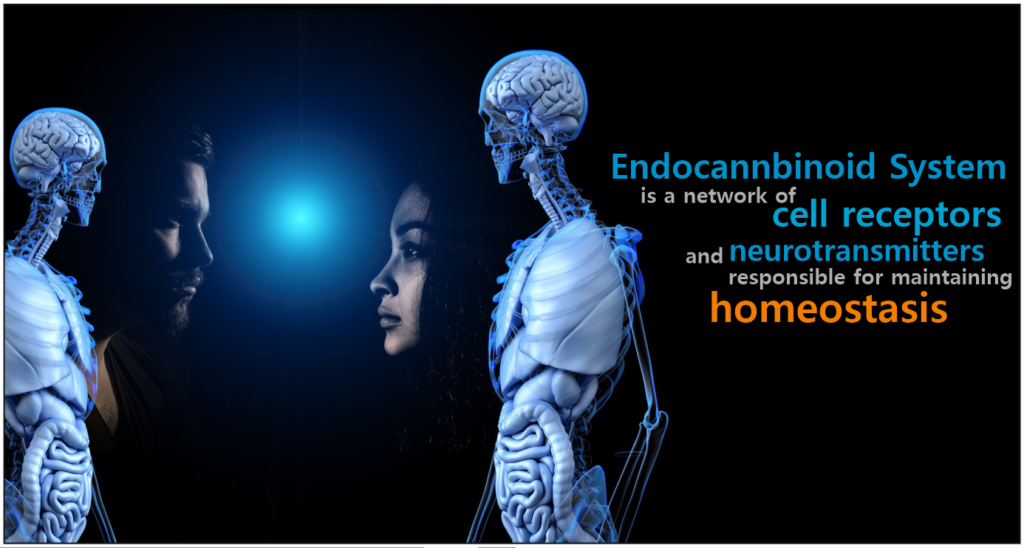 The endocannabinoid system present in our body comprises an extensive network of cell receptors and neurotransmitters. The ECS is responsible for maintaining homeostasis in our body.
The endocannabinoid system present in our body comprises an extensive network of cell receptors and neurotransmitters. The ECS is responsible for maintaining homeostasis in our body.
Endocannabinoid receptors interact and express through complex pain pathways influencing pain management of many diseases. We have two types of cannabinoid receptors in our ECS – cannabinoid 1 (CB1) and cannabinoid 2 (CB2) receptors which interact with cannabinoids present in cannabis when consumed. In fact, of the two CB receptors, CB1 receptors are highly expressed in the tissues of the uterus and other non-reproductive organs. CB2 receptors are found in multiple tissues, including lung, intestines, pancreas, skin and elsewhere.
This endocannabinoid system could serve as a target for treating many ailments troubling us women, namely endometriosis, premenstrual syndrome, chronic pelvic pain, menopause. It can also improve our sex lives adding loads of love and joy to lovemaking.
Cannabis is widely understood to have analgesic, anti-anxiety, antispasmodic, muscle relaxant, anti-inflammatory and anticonvulsant effects. It has the proven potential to manage. In fact, adjunctive therapy for pain management using cannabis has seen a dramatic surge in the recent years.
Endometriosis
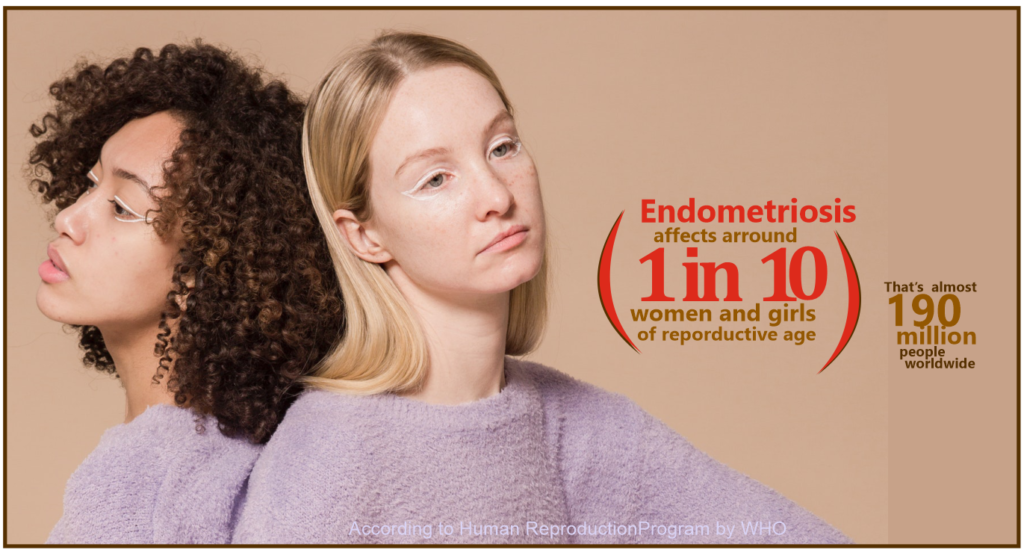 Endometriosis is a cruel truth of women’s health. It is associated with chronic pain over a long period of time. When the lining of the womb – the endometrium – grows outside of the womb cavity it adversely affects reproductive organs causing infertility, pain, anxiety, and quality of life. It is also known to impede cognitive function.
Endometriosis is a cruel truth of women’s health. It is associated with chronic pain over a long period of time. When the lining of the womb – the endometrium – grows outside of the womb cavity it adversely affects reproductive organs causing infertility, pain, anxiety, and quality of life. It is also known to impede cognitive function.
Women suffering with endometriosis are reported to have lesser CB1 receptors, making them susceptible to pain.
However, a study in 2010 showed cannabinoids had an anti-proliferative effect on endometrial tissue. Simply put, cannabinoids inhibit the spread of harmful endometrial tissue overgrowth. The cannabinoids prevented the onset of conditions of endometriosis.
Tetrahydrocannabinol (THC); the main psychoactive constituent of the cannabis plant is also being studied by Gynaecology Service of the Hospital Clinic of Barcelona with the aim to start a clinical trial on THC as a possible cure of endometriosis in women.
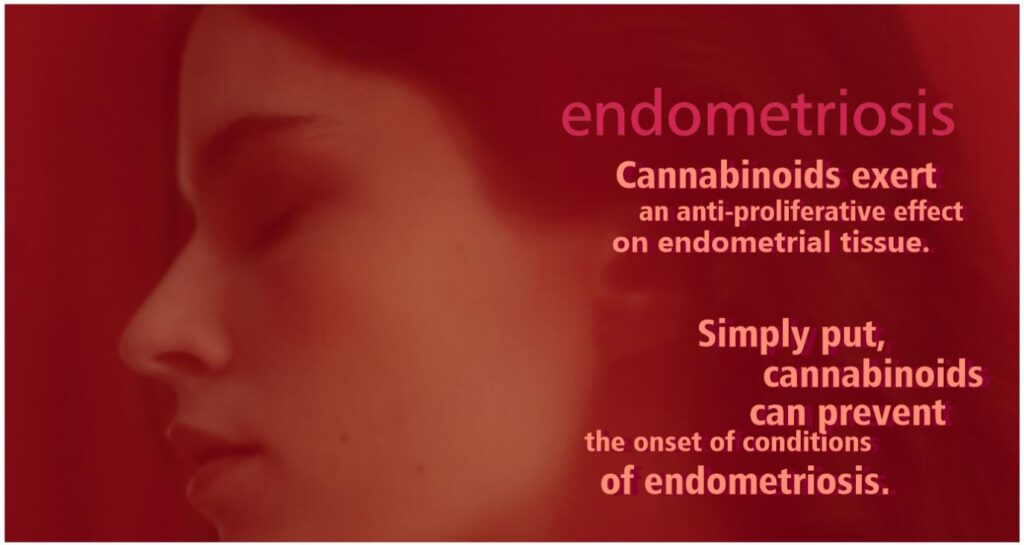 Also, cannabis is an effective pain suppressant.
Also, cannabis is an effective pain suppressant.
Cannabis was found to be effective for pelvic pain, gastrointestinal issues and mood during a small experiment. In this experiment women with endometriosis smoked cannabis to treat pain. Cannabis appeared to be effective in alleviating pelvic pain, a few gastrointestinal issues and the mood as well.
Thus, cannabis not only helps mitigate the chronic pain associated with endometriosis but also mounts an effective barrier in the onset of endometriosis.
However, we are still in the early stages. For cannabis to be approved as a treatment to manage the complex conditions of endometriosis is not too distant. We hope to make further breakthroughs. Till then we can only experiment on personal levels.
Cannabis for menstrual pain
We women have to endure through monthly cycles of pain and discomfort.
The prime reason for the menstrual cramp is release of a hormone-like compound – prostaglandins. This compound causes your uterus to contract. There’s the reason for those nagging, upsetting pain.
As we all know, cannabis has the ability to dull the pain sensation. It may do so for menstrual cramps as well. But is it very effective? The answer is no.
Cannabis, unlike Non-steroidal anti-inflammatory drugs (NSAID) like Ibuprofen and Aspirin, cannot block the production of prostaglandins, but to a degree lessens the sensation of pain. THC in cannabis triggers the release of dopamine – the feel-good hormone and helps alleviate menstrual cramp the other way round. Cannabis is also known to possess anti-inflammatory properties, so it may help mitigate period pain. Having said, clinical evidence strongly suggesting cannabis can ease menstrual cramps still to come.
What gives me hope is the fact that Female pelvic organs are known to have high density of cannabinoid receptors. The reason for high density of receptors in the gynaecological urinary tract, is to maintain a homeostatic balance in the body.
What about cannabis suppositories?
There have been mentions of cannabis infused suppositories, which women insert into their vagina to seek relief from menstrual pain. Cannabis infused topicals, creams and sprays are being advertised. Gynaecologists have expressed their amusement at such claims. It is best that we wait and watch before more concrete evidence emerges.
Even though clinical evidence and research on cannabis for menstrual symptoms is scarce, many women are using cannabis in Canada to lift their mood in the difficult and painful period.
Premenstrual syndrome
Premenstrual Syndrome, commonly referred to as PMS, occurs 1-2 weeks before the start and end of our periods. It is a much broader syndrome including physical, emotional, and behavioral symptoms.
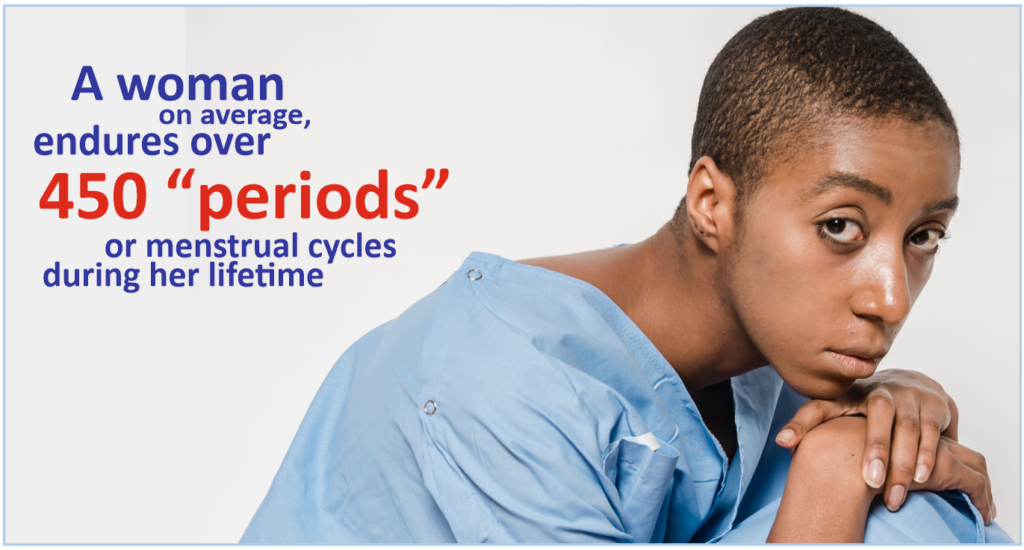 Women on average, endures over 450 “periods” or menstrual cycles during her life.
Women on average, endures over 450 “periods” or menstrual cycles during her life.
A fertile woman has to negotiate a lot more than with distressing headaches, and cramps. We have to wade our way through abdominal bloating, breast-tenderness, sleep and appetite fluctuations, fatigue, and so much more. The psychological symptoms are anger, anxiety, depression, irritability, forgetfulness etc. Though some of us may get through eating a bar of chocolate or strapping a heating pad. But most of us need a lot more than that.
Women are increasingly discovering the benefits of cannabis. The cannabinoids do provide more than just pain-relieving benefits. It lifts the mood, provides a positive burst of energy and helps sleep better.
Our women circle is abuzz with the mention of a few cannabis strains for combating period difficulties are indica dominant Black Cherry Cheesecake and sativa dominant Blue Dream. Both hybrid strains are potent enough to provide a cerebral high taking one’s mind off while relaxing the body being tormented by cramps and pains.
Those of us who are not comfortable smoking, vaping and dabbing cannabis, can take CBD infused chocolates, gummies and even serve themselves with THC infused shakes and smoothies.
Instead of heating pads you can even try cannabis patches for localized pain relief. These transdermal adhesive patches ensure a controlled release of cannabis dose through our porous skin membrane. Cannabinoids included in these patches have analgesic and anti-inflammatory properties to provide us relief.
Premenstrual Dysphoric Disorder (PMDD)
Premenstrual Dysphoric Disorder is a more severe form of Premenstrual Syndrome. It is characterized by all the symptoms of PMS but with higher degree. A study indicated that women with lack of information and medical assistance to deal with PMDD in all probability suffer a loss of almost three quality years. This means all those anxious discomfort and painful irritating hours of not being able to do anything amounts to three good years of life. A valuable chunk of life is lost. We could have spent this time doing our own things enjoying the gifts of family, friends and ourselves.
We are advised to make changes in our lifestyle including dietary changes. Even Non-Steroidal Anti-inflammatory Drugs (NSAIDs), diuretics (for increasing excretion of fluids), antidepressants (for moods and depression) are prescribed for PMS and PMDD. Many of us resort to hormonal treatments for these two.
And then there is Chronic Pelvic Pain (CPP). This condition of severe pain in pelvic organs and region affects up to 15% of women in the United States.
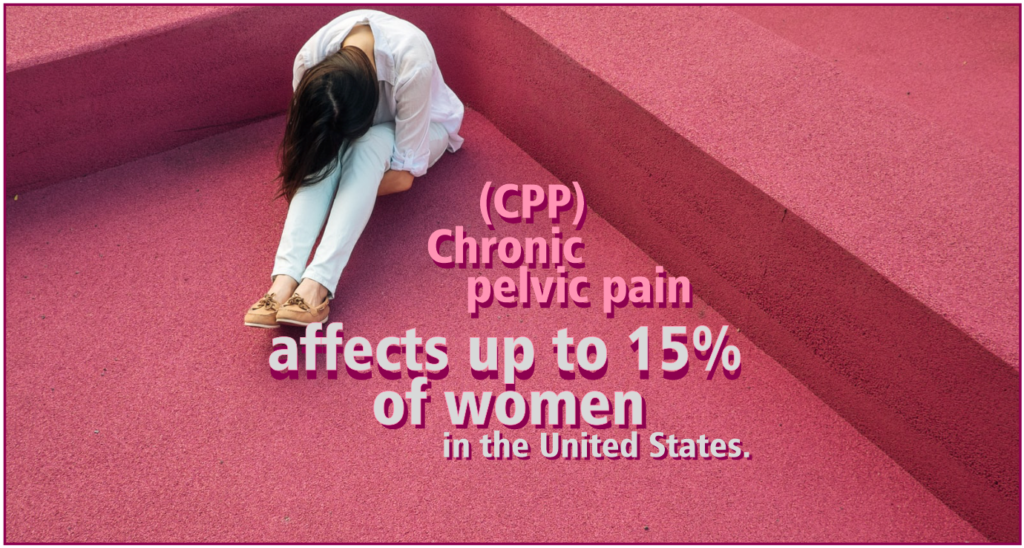 But nature is also kind. It did provide cannabis. Many of us agree, it does save quite a bit of agony we all have to go through. For many of us who have not been benefited with traditional treatment and medications, we have to look elsewhere.
But nature is also kind. It did provide cannabis. Many of us agree, it does save quite a bit of agony we all have to go through. For many of us who have not been benefited with traditional treatment and medications, we have to look elsewhere.
Cannabis has emerged as a non-hormonal alternative. It is being preferred due to fewer negative side effects in comparison to the currently prescribed medications. Though it must be understood very clearly that almost no formal research has taken place due to restrictions from the government. Though little evidence is available of cannabis ameliorating symptoms overplaying with PMS and PMDD.
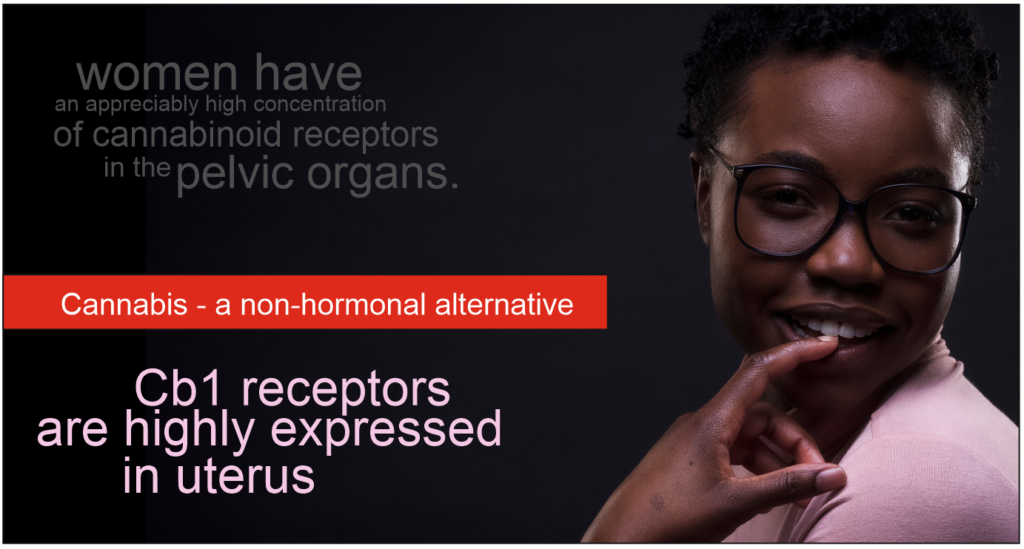 The mucous on our vaginal membrane has been identified with an excellent ability to absorb medicinal products. This puts vaginal suppositories at a unique position to transport medications faster and effectively. Treating women’s reproductive conditions can be a whole lot easier. With vaginal suppositories patients rapidly deliver healing cannabinoids to the pelvic organs. Women have an appreciably high concentration of cannabinoid receptors in the pelvic organs. CB1 receptors are highly expressed in the uterus. Women self-manage Chronic Pelvic Pain with cannabis.
The mucous on our vaginal membrane has been identified with an excellent ability to absorb medicinal products. This puts vaginal suppositories at a unique position to transport medications faster and effectively. Treating women’s reproductive conditions can be a whole lot easier. With vaginal suppositories patients rapidly deliver healing cannabinoids to the pelvic organs. Women have an appreciably high concentration of cannabinoid receptors in the pelvic organs. CB1 receptors are highly expressed in the uterus. Women self-manage Chronic Pelvic Pain with cannabis.
Menopause and Cannabis
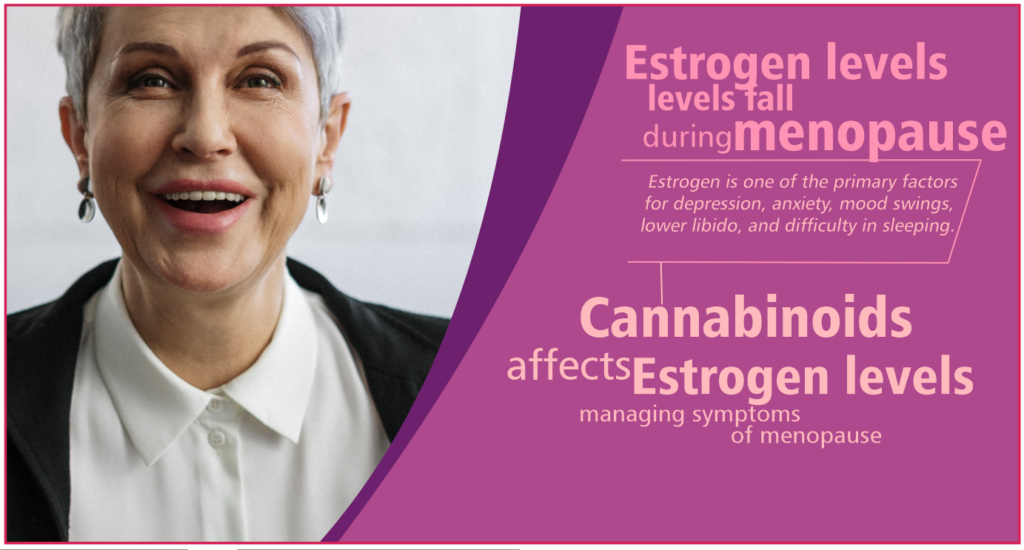 A new study recently found 1 in 4 women have tried cannabis to manage menopause symptoms. Insomnia, mood changes, vaginal dryness, and hot flashes are some of the typical symptoms they managed to ease with cannabis.
A new study recently found 1 in 4 women have tried cannabis to manage menopause symptoms. Insomnia, mood changes, vaginal dryness, and hot flashes are some of the typical symptoms they managed to ease with cannabis.
Cannabinoids affect Estrogen levels. During menopause Estrogen levels fall. It is one of the primary factors for depression, anxiety, mood swings, lower libido and difficulty sleeping experienced during the onset of menopause.
Hormone therapy is usually employed for managing hot flashes for women undergoing menopause. However, all women are not equal. Women not responding well for hormone therapy found cannabis a big help, Cannabinoids were reported to be satisfactorily effective in managing symptoms of hot flashes and insomnia. Cannabinoids are effective stress -busters. The Entourage effect of cannabis and ability to bring in homeostasis seems quite appropriate for menopause.
Cannabis sublingual, topicals and edibles are recommended by other women folk fighting menopausal symptoms.
Sex Life and Cannabis
Cannabinoids produced exogenously and endocannabinoids interact with hormones and neurotransmitters affecting several brain areas mediate sexual behavior and function.
A survey was conducted and found that cannabis does enhance sexual function in men and women. 38.7% said sex was better, 58% said their desire for sex increased, 73% reported increase sexual satisfaction, 74% reported increased sensitivity to touch, 65% reported increased intensity of orgasm.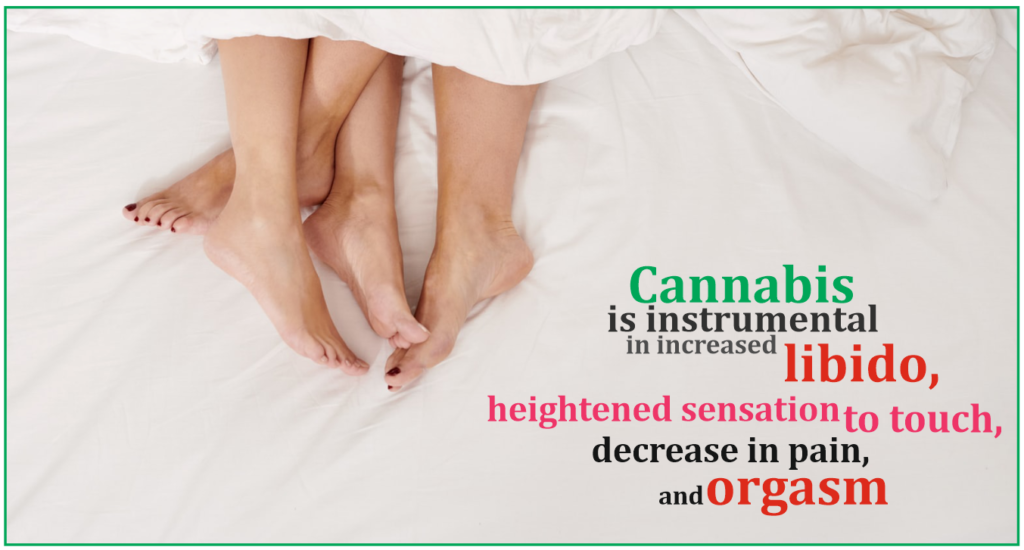 Cannabis is instrumental in improvement in many aspects of sexual experience including increased libido, heightened sensation to touch, decrease in pain, orgasm and others. But this is certainly not conclusive. A clear and greater understanding of the role of the endocannabinoid system in women is still needed. There is a definite lack of evidence-based literature. Development in these areas can open doors for treatments for female sexual dysfunction.
Cannabis is instrumental in improvement in many aspects of sexual experience including increased libido, heightened sensation to touch, decrease in pain, orgasm and others. But this is certainly not conclusive. A clear and greater understanding of the role of the endocannabinoid system in women is still needed. There is a definite lack of evidence-based literature. Development in these areas can open doors for treatments for female sexual dysfunction.
Beauty and Skincare
Looking younger, beautiful and attractive is more than a religion to us women. We are wired to look beautiful to more than just attract the best possible mates. Daniel Hamermesh, author of Beauty Pays, explains how beautiful people find a lot of things easy.
On an average a woman uses 16 skincare and related products before heading out from her home. It has been estimated that we women spend on an average $250 a month spending between $200,000-$300,000. The downside of being a woman is that we end up spending one third of our incomes on beauty and skincare.
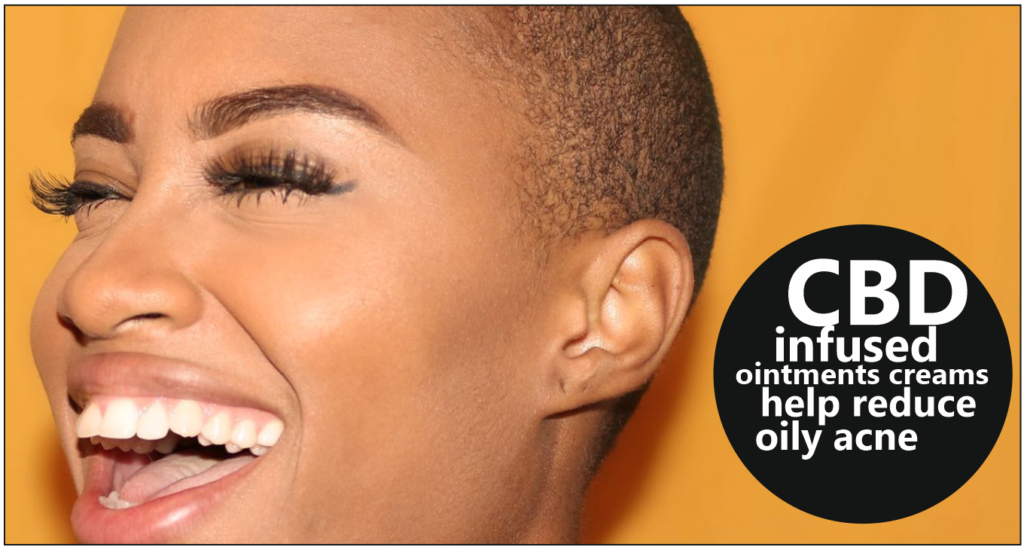 So, where and how does cannabis fare in beauty and skincare products?
So, where and how does cannabis fare in beauty and skincare products?
Cannabidiol (CBD) is an active ingredient in a large number of beauty and skincare products. CBD is a non-psychoactive cannabinoid present in a cannabis plant. Cannabis distillate, or cannabis isolates contain 99% CBD extracted from the plant after a highly evolved distillation process. This cannabis distillate concentrate is then added to sunscreens, masks, lip balms, moisturizers, and others.
CBD is known to reduce dryness. The CBD infused ointments boosted hydration in the skin, improving elasticity. Due to anti-inflammatory properties, CBD ointment creams help reduce not only acne but are found to be effective on eczema and psoriasis.
For women keen on avoiding steroid-based topical creams and ointments, CBD is an excellent non-steroidal option. CBD ointments due to their anti-inflammatory capabilities can work as an anti-aging agent as well.
While there is a lot of buzz about cannabis and CBD, it must be understood that it is not a be-all-end-all solution. But it gives us a lot of hope.
Conclusion
Cannabis does offer us a lot of hope. It has the potential to make a big difference in our lives. It is an uncontested and undenied truth that it is difficult to be a woman in any part of the world, yet we brace ourselves out. Cannabis with its natural abilities can make an appreciable difference in our lives. We read how cannabis is helping us women to ride through difficult phases in our lives. It has shown the potential to influence medicine and treatments for many medical issues central to women’s sexual and general health as well.
However, we understand that cannabis is still a Schedule 1 substance. We need greater support from legislation, scientific and medical fraternity to be able to come up with greater clarity on cannabis and its capacities to impact our lives. While cannabis is still considered an illegal substance in the United States under federal guidelines, 33 states have already passed laws making its use legal for medical and/or recreational use. However, the political climate with regard to cannabis is different in Canada with the Farm Bill announced in 2018, marijuana can be legally used for both recreational and medicinal purposes in Canada. We still have a long way to go.
Cannabis is making a difference in the lives of women. We hope to see more of it in times to come.


